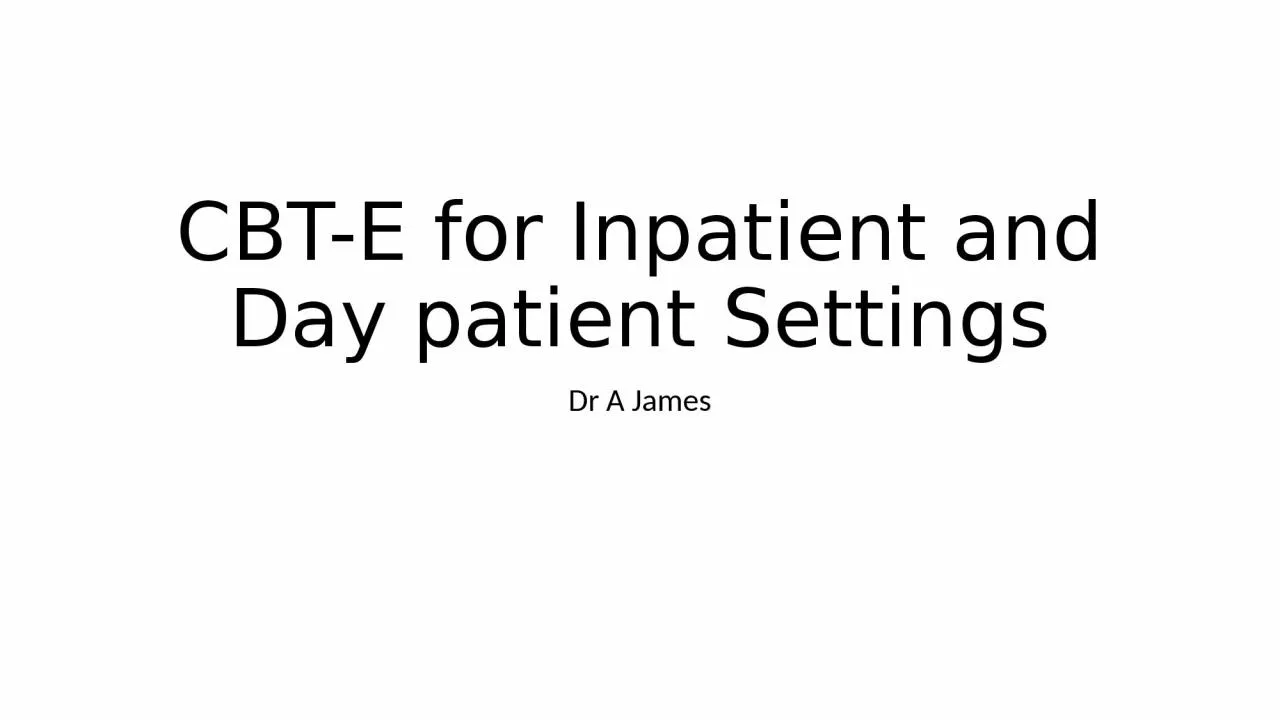

Dr A James History Inpatient care often operated without a defined model Weight restoration seen as central Indeed in some cases weight restoration is seen as the only option or goal Regimes frequently paternalistic medical and more than often coercive ID: 1042165
Download Presentation The PPT/PDF document "CBT-E for Inpatient and Day patient Sett..." is the property of its rightful owner. Permission is granted to download and print the materials on this web site for personal, non-commercial use only, and to display it on your personal computer provided you do not modify the materials and that you retain all copyright notices contained in the materials. By downloading content from our website, you accept the terms of this agreement.
1. CBT-E for Inpatient and Day patient SettingsDr A James
2. HistoryInpatient care often operated without a defined model.Weight restoration seen as central. Indeed, in some cases weight restoration is seen as the only option or goal.Regimes frequently paternalistic, medical and more than often coercive.Coercive practices include: not listening to the patient and having a defined, mechanistic approach. Lack of choice. Various approaches, with the same patient, some contradictory.Approaches not necessarily focused on ED pathology. cses
3. Why Change ?Outcomes poor.Length of stay long, often to target weight.Relapses frequent.Coercive practices with poor relationships, draining ward atmosphere, high degrees of stress. Frequent NG tube feeding.Oppositional attitudes ( both staff and patient).
4. How did we change ?Attended a 2 day workshop by Chris Fairburn on CBT-E.Right time, right place, right people.Trust allowed new ways/treatment methods to develop as part of the University/Trust link.Freedom to move – things had to be better.Realisation that change took time as attitudes and practices were engrained
5. Change – the process We set up a small working party. All were interested and committed to change . We specifically excluded people ( even senior people) who were not directly involved or contributing, or going to contribute to the new programme.We were allowed on line training so there was a personal and group investment. We took an active decision to involve and inform everyone at all levels We worked aa a group - it takes courage.
6. Change – the process.We informed everyone regularly, even if they were not seemingly interested or receptive .Need senior people to push for change.Have to listen to worries and concerns of others.Anticipate resistance – change is often feared.Be committed don’t waiver or compromise too much.Keep track of progress as one looses track and one feels the process is being derailed. People become dispirited – why is it taking so long? what are we doing? will it work?
7. Take the plunge!First round table we were all anxious! A step into the unknown- exciting and potentially risky, dangerous.We employed a family therapy technique: using our weakness/lack of experience as a strength: We had to follow the model closely, without deviation.We were open and told patients and parents that we were new to this therapeutic model, but that we were following the protocol closely. We highlighted the expertise of Prof C Fairburn and team, especially the research findings from Oxford, Leicester (adult) and Italy (residential and adolescent).
8. Taking the plunge.Things have to be better.We are talking to the patient. Revolution: More than collaboration - We put the patient at centre stage (See Round Table). We had 6 monthly consultation with Arianna Banderali from Italy “You are the therapist, I am your coach”.
9. SettingNHS Adolescent Unit.We accept medically ill patients.We accept urgent/emergency referrals.We accept detained patients.
10. Setting We run 3 programmes:MedicalFBTCBT-EAnd no others!
11. Engagement is all.
12. How do we engage the patient? Take the pressure off – you and the patient.Talk and discover. Pros and Cons for both remaining the same and changing.